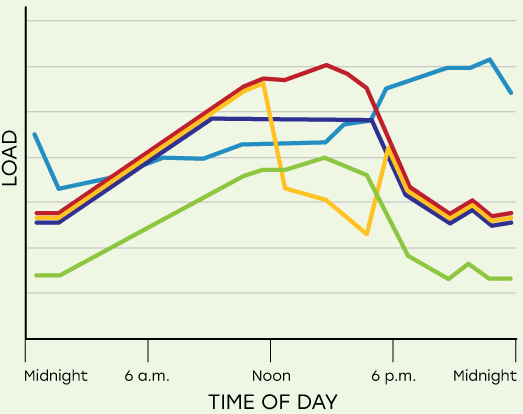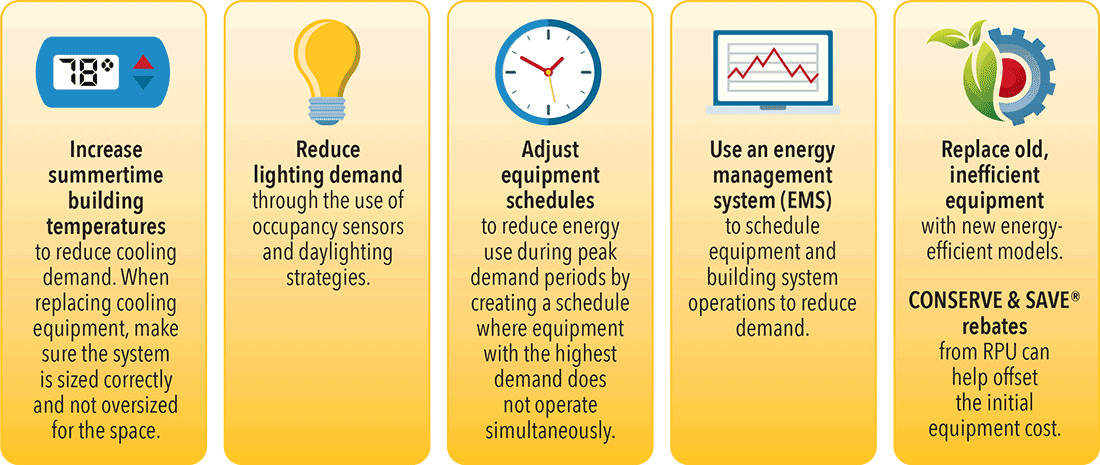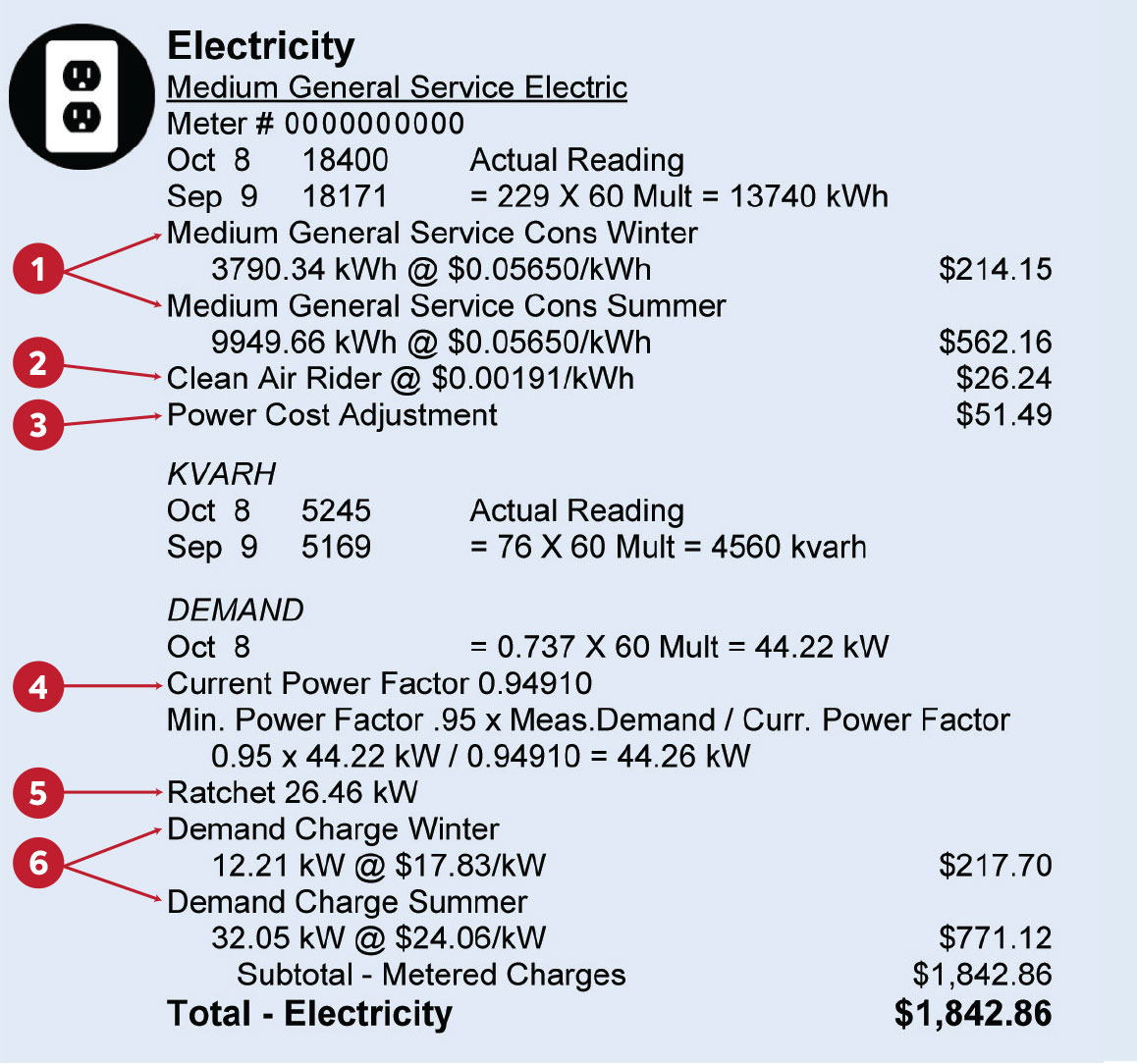Understanding Demand and Energy
Understanding your Rochester Public Utilities (RPU) bill can lead to lowering your bottom line and providing you with important information such as managing and conserving your energy, operating more efficiently, and identifying savings opportunities. Customers with a monthly demand of 25 kW or higher have two main components in their electric billing: Energy and Demand.
Power Demand - kW
- Measured in kilowatts (kW) and represents the rate at which electricity is consumed.
- Billed based on maximum, or peak demand recorded in 15 minute intervals during the billing cycle.

Example: Max speed recorded on a road trip
(speedometer – top speed recorded on our road trip was 84 mph)
Energy Consumption – kWh
- Measured in kilowatt-hours (kWh) and represents the amount of electricity that has been consumed over a certain time period.
- Billed based on total usage of energy consumed per hour during the billing cycle.

Example: Traveled distance recorded on a road trip
(odometer – we traveled 500 miles)
Why does RPU charge businesses for demand?
To remain reliable, RPU has to have capacity readily available, and must be prepared to meet the highest cumulative peak on the grid at all times, thus providing the maximum amount of electricity “on demand” by customers at any given time. In addition, transmission and distribution systems must be sized accordingly to handle the delivery of electricity at a constant level. This costs money, therefore, electric utilities tend to charge demand to help meet the cost, which is spread across commercial customers who need this capacity to meet their building operations.
 Peak demand is defined as the single point at which the maximum rate of energy is used during the billing cycle, measured in 15 minute intervals. Knowing exactly when and how customers' energy is being used in their buildings is essential to reducing demand, decreasing consumption and emissions, and ultimately lowering energy costs for RPU and for our customers.
Peak demand is defined as the single point at which the maximum rate of energy is used during the billing cycle, measured in 15 minute intervals. Knowing exactly when and how customers' energy is being used in their buildings is essential to reducing demand, decreasing consumption and emissions, and ultimately lowering energy costs for RPU and for our customers.
Demand Profile of Various Load Management Methods

- – Baseline
- – Energy Efficiency
- – Demand Limiting
- – Demand Shedding
- – Demand Shifting
RPU’s energy costs are highest during peak hours
Residential – Peak is in the afternoon/evenings, when people come home and everything gets turned on simultaneously.
Commercial – Peak hours are highly dependent on production and operation hours.
Energy is most expensive to purchase during peak time, thus we promote various strategies of conservation:
- – Energy Efficiency – Conserve via installing newer, more efficient equipment
- – Demand Limiting – Equipment which shuts off once a set demand threshold is reached
- – Demand Shedding – Turning equipment off during peak hours or running a generator (consumption less, demand less)
- – Demand Shifting – Moving work tasks from peak hours to off peak hours (consumption same, demand less)
Level the Peaks - Lower your Demand - Lower your Bill
How do you reduce your peak demand charges? Although every business is unique, the following are some operational and equipment strategies that may help you reduce your peak demand: With these measures, you can reduce your peak demand and save money on your energy bills. Controlling your energy use during peak periods doesn't necessarily require a big investment. Contact one of our Energy and Environmental Advisors below for more insight on lowering your demand or view a list of our Conserve & Save™ rebates available to our commercial customers.
With these measures, you can reduce your peak demand and save money on your energy bills. Controlling your energy use during peak periods doesn't necessarily require a big investment. Contact one of our Energy and Environmental Advisors below for more insight on lowering your demand or view a list of our Conserve & Save™ rebates available to our commercial customers.

| CONSUMPTION CHARGE | DEMAND CHARGE | |
| Customer Type | Commercial | Commercial with Demand of over 25 kW |
| Unit of Measure | Kilowatt-hours (kWh) | Kilowatts (kW) |
| What are you paying for? | Total amount of electricity used in a billing cycle | Peak Demand – maximum level of energy used during a billing cycle |

| HOW TO READ YOUR RPU BILL ELECTRICITY CHARGES | |
| 1 | Electric Usage Charge is the total metered kilowatt-hours (kWh) used. The rate per kWh is then multiplied by the kWh used for the current billing period. NOTE: Two energy charges may appear during the transition between summer (Jun–Sep) and non-summer (Oct–May) rates or when any changes to our rates occur (Dec–Jan). |
| 2 | Clean Air Rider covers the bond payments for the Emission Reduction Project (ERP). All residential, commercial, and industrial electric customers are impacted by the charge. The amount you pay on the Clean Air Rider is dependent on your electric usage. The rate of the Clean Air Rider will change each year depending on the debt service payment schedule. The payments are scheduled to be complete by 2030. |
| 3 | Power Cost Adjustment is charged if the cost to supply the electricity needed for our customers exceeds projections. This adjustment is made in cases such as high fuel costs, higher market pricing for electricity, or the load is higher than projected. This adjustment is based on your electric usage and varies. |
| 4 | Current Power Factor gauges how efficiently delivered energy is used. It can be viewed as relationship between the amount of useful energy (kW) and the amount of non-working energy (kVAR). A good power factor (above .95) is the result of devices that utilize close to 100% of the delivered electricity with no energy being wasted. Measured power factor below .95, will result in an adjusted billed demand, and can become costly to both customers and RPU. |
| 5 | Ratchet is the minimum demand billed in the months of Oct-May. It is established during the summer months (Jun–Sep) and set at 50% of the highest demand measured during those months. |
| 6 | Demand is measured as the maximum amount of energy (kW) used at single point during a billing cycle, also referred to as peak demand, and used to calculate a demand charge. NOTE: Two demand charges may appear during the transition between summer (Jun–Sep) and non-summer (Oct–May) rates or when any changes to our rates occur (Dec–Jan). |
To download a printable pdf of this information click here.


